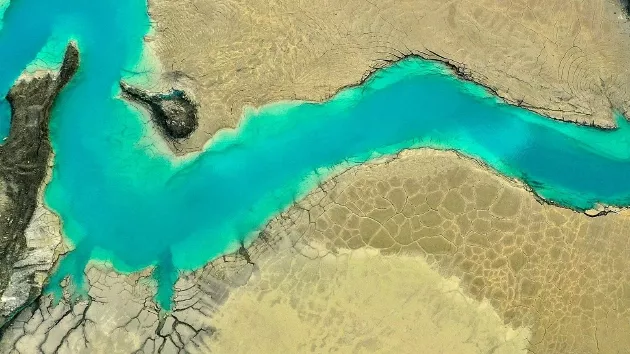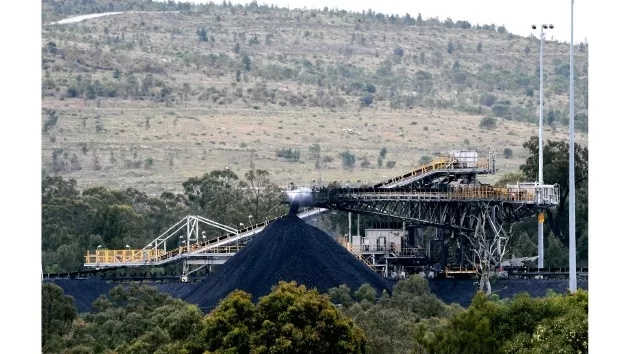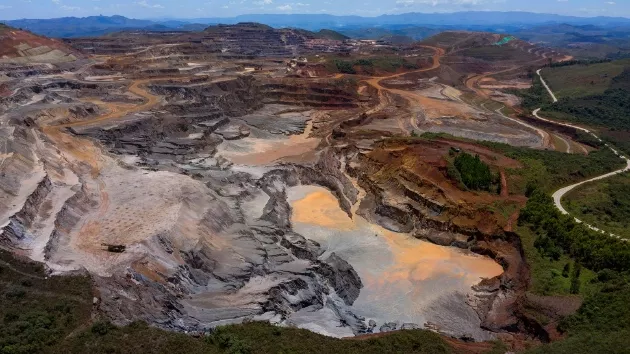According to foreign media reports, mining has provided the necessary fuel for modern society, but it has also caused extensive environmental damage. What happens if we stop mining? The miner's creed is: "if you can't plant it, you can only dig it out." Mining minerals, metals and fuels from the ground is one of mankind's oldest industries, and our appetite for mining is growing.

Today, society is far more dependent on the type and quantity of mineral exploitation than ever before. If you live in a middle-income country, you will use about 17 tons of raw materials every year, which is equivalent to the weight of three elephants, which has doubled from 20 years ago. In high-income countries, the figure is as high as 26 tons, equivalent to four and a half elephants.
For many substances, the cost of re mining has always been lower than that of recycling, leading some experts to warn that the pressure on nature caused by mining is increasing. There are also growing concerns about the pollution and loss of biodiversity caused by mining. In addition, the social impact on local communities may sometimes outweigh the benefits of mining.

The picture shows the Congolese people looking for cassiterite - the main ore for tin production.
But what if we completely stop mining fossil fuels and minerals? What would happen if human beings decided to ban the use of materials in the earth's crust in order to better protect the environment?
Of course, this situation is impossible and will be resisted by many people. But if we just imagine what the world will be like when we are not allowed to mine underground materials, we may be able to reflect on how dependent we are on mineral exploration and how foolish we are to discard all kinds of raw materials in vain. These wasted materials had the opportunity to make new materials, but we turned a blind eye to it.

The town of Pedro de Valdivia in Chile has become uninhabited after the closure of a nearby mine. Once mining activities stop, many "unmanned towns" will emerge rapidly.
So how will this thinking change the way we use materials today
Over the past three years, Victor moss, a researcher in Geoinformatics and sustainability at the Vienna University of economics, has been studying surface satellite images to estimate the total area of Mines currently mined by mankind. The result surprised him: "the total area is as large as a country, and this is only a reported mine."
The land area occupied by the mine has never been surveyed by satellite before, so it is difficult to train computers to identify the mine from thousands of photos. Mauth and his team had no choice but to estimate with their own eyes. They spent countless hours staring at the polygon of pits, shafts and tailings. "I can even dream of polygons when I sleep," moss said
He found that the aboveground part of the mine covers an area of about 100000 square kilometers, which is larger than that of Austria and five times that of Wales. "This is just a mine in an active mining state."
Mining is also one of the most basic forms of business, and many mining sites have not been reported. "The actual total area of mines around the world is even larger."

In a world where mining has ceased, waste from old mines and tailings ponds will become opportunities for us to extract metals.
On the first day when mining stops all over the world, relevant businesses will gradually stop. Workers in Congo's underground cobalt mine will put down their shovels, the huge conveyor belt in German coal mines will stop rotating, and boats in the Mekong Delta will stop pumping river sand.
The first shock wave will hit the job market. After the stoppage of mining, it is expected that 4 million formal jobs will disappear around the world. And the impact is more than that.
"In addition, there are many people who rely indirectly on mines for survival, so the impact will be greater," said Eleanor Leibler, who studies the social impact of mining at the University of Queensland. More than 100 million people's livelihoods are related to artisanal mining and will lose their jobs if the mining industry stops.
In his study, Leibler analyzed the impact of the cessation of mining on remote towns in Australia. "Mining operations in rural areas may have lasted for decades, and many communities rely on mining for survival." If mining is stopped, many "unmanned towns" will emerge almost overnight.

When mining stops, the never-ending coal conveyor belt will soon stop running.
These impacts will not always be confined to these communities. By the seventh day, the scope will spread to the whole society. "Energy will be the biggest concern." John Thompson, a mining consultant and sustainability professor in Vancouver, pointed out that "coal will be used up first."
Coal is large in volume and heavy in weight. Therefore, it is mostly circulated in the form of short supply chain in the world, and it is often sent directly from coal mines to power stations. "Because coal takes up too much space, power stations will not store a large amount of coal." When mining stops, the conveyor belt of the power station will soon be empty.
Considering that 35% of the world's people still rely on coal for power generation, few countries have survived the sudden energy crisis. However, the proportion of coal power generation varies all over the world, such as 15% in Europe, 63% in China and 84% in South Africa. Therefore, people can soon feel the energy inequality between different countries.
If the problem of insufficient power supply is not solved, governments may need to learn from the past. The coal mine strike experienced by Britain in the 1970s is an example. At that time, it had to take turns to cut power and electricity quotas to control losses. "The policy of 'three days a week' may be introduced again," Thompson said He was referring to the British government's reduction of the number of working and manufacturing days per week from five to three in response to the power shortage caused by the strike and oil crisis in 1973,
In modern society, the reduction of power supply will indirectly cause another blow - the sharp decline of communication activities. Many Internet servers still rely on coal-fired power generation, and their number is bound to be reduced. Mobile networks may last longer, but with less power, charging devices will soon become a luxury. The telephone line will last as long as the backup generator and battery can support its operation.
Before long, bulk materials will become scarce. Sand and gravel, the key raw materials for making concrete, have relatively small reserves and may be exhausted in two or three weeks.
"In terms of weight, sand and stones are the most mined solid materials." Aurora Torres of the Catholic University of Leuven in Belgium pointed out. She specializes in environmental stress caused by the use of sand. "We extract more sand than anything else." The United Nations estimates that we mine up to 40 to 50 billion tons of sand every year.
Concrete can be recycled to a certain extent, but we use new concrete much faster than the current recycling speed. In addition, there are concerns about the quality of concrete. "Most recycled concrete will be degraded and can only be used for paving and other purposes." Therefore, although many people are trying to improve the concrete recycling process, the construction of new houses will decline significantly in the short term.
At the same time, as natural gas begins to run out in a few weeks, affecting heating and cooling capacity, the temperature in existing houses will become more uncomfortable. In economies that rely on natural gas for power generation, such as the United Arab Emirates (95%), Russia (45%), the United States (41%) and the United Kingdom (36%), blackouts will occur more and more frequently. Plastic production will also be limited to recyclable plastics.
But in addition to energy and construction, the impact of modern society is far more than that. "After about two months, as the metal industry began to be affected, the situation really became interesting." Thompson pointed out. Many metals obtained through mining are traded through the London and New York stock exchanges, and the changing figures in the trading hall also reflect the transfer of inventory between global warehouses in the real world. Copper is an excellent conductor and indispensable to almost all electronic products. Thompson estimates that copper stocks will be completely depleted in six to 10 weeks.
This will lead to a huge surge in metal prices. "It's not hard to imagine that there will be more thieves." About a decade ago, copper prices reached an all-time high, and the crime rate increased. Buildings, street lamps, railway transmission lines... Anything containing copper will be stolen and sold for money. Not only copper, but also all industrial metals, including copper, iron, aluminum, zinc, lead and nickel, which account for 98% of all mining metals. The shortage of metals will make us realize how important they play in society.
Most countries have their own mining industry. China, Australia and the United States are the countries with the highest output value of raw materials in the world, but in other countries, mining accounts for a larger proportion of the economy. In at least 18 countries, metal minerals and coal account for more than half of exports, and even more than 80% in some of them. If the metal mining activities are terminated, the economies of some countries will face major crises, such as the Republic of Suriname dominated by gold, Congo dependent on cobalt, and Mongolia, one of the largest exporters of copper.
Simon jovit, an economic geologist at the University of Nevada, pointed out bluntly: "this will be the end of modern society." Moreover, we are now mining more than at any time in history.
Jowett pointed out that mobile phones can well reflect our increasing dependence on various metals. In the 1980s, a mobile phone only needed about 20 different elements; Today's smartphones have doubled the types of elements they need. "Modern life is in great demand for minerals and metals. Without these materials, we wouldn't be able to make this video call at all."
Three months after the end of mining, stocks of various rare earth metals required for science and technology will be exhausted, and the pharmaceutical, automotive, electronic products and construction industries will begin to be worried. This will also lead to an "unprecedented" wave of large-scale unemployment.
Just as the supply chain was about to collapse, oil reserves were finally exhausted. The United States has the largest strategic oil reserves in the world, with a total of 730 million barrels of oil scattered throughout the country for up to three months. The production of gasoline, diesel, plastics and asphalt will also come to an end. Since then, mankind has bid farewell to the era of fossil energy.
In a few months, the global food supply will also be in crisis. It is estimated that about 50% of the world's food production depends on synthetic fertilizers, which are produced from different formulas of phosphorus, potassium and natural gas. Lower crop yields will lead to a shortage of food supplies. "The situation will be particularly serious in countries where the natural climate does not support food production," Thompson said
Nuclear fuel will be stored for months in advance, so nuclear energy will not be used up until a year later. Renewable energy will become the last king. Countries with the largest per capita renewable energy will therefore have a huge advantage. Iceland and Norway almost all of their energy comes from hydropower and geothermal power generation, so they will become the most "equipped" countries in this socio-economic storm.
But fate is cruel. Although there is a huge demand for new renewable energy, the employment rate of wind and solar power stations will plummet. Moreover, the contradiction of renewable energy is that the existing forms of power generation need to use a large amount of non renewable metals.
"As the use of renewable energy increases, although the use of fossil energy will decrease, the use of battery metals such as cobalt and nickel will increase significantly. The battery semiconductors of solar panels need a lot of silicon. The magnets responsible for power generation in wind turbines need rare earth metals such as neodymium."

The picture shows Alto Bandeira iron mine in Brazil. Copper, iron, aluminum, zinc, lead and nickel account for 98% of the total metal mining.
The pressure to recycle metals will soon increase. "We have recycled a certain amount of metal." "Most base metals and some other elements have recovered more than 50% at the end of use," Jowett said
But other metals vital to renewable energy are "only lost according to the existing design". "The way we currently use these metals itself determines that they cannot be recycled." Because there are many kinds of elements used in different technologies, but the amount of each element is small, and the use methods are diverse, it is difficult to separate various metals.
But even if the technology that can extract these trace rare earth metals is developed, it is impossible to meet the huge demand for renewable energy. "The demand for these metals has now exceeded production by several times," Jowett said According to the world bank, if the global warming rate is kept below 2 ℃, the annual output of graphite, cobalt and lithium will increase five times by 2050.
In addition, the global distribution of metals that have been mined is also extremely unfair. Most of the mined and processed metals are imported into developed countries, which means that relatively few renewable metals are available in developing countries. A study shows that the total amount of metal available to the richest 20% of the world's population accounts for 60% to 75% of the world's metal reserves in use, which is even more unfair than carbon emissions. Therefore, in a new world without mining, we must carefully consider the equitable distribution of metals.
However, in the case of scarcity, people will eventually make a breakthrough in the design and recycling of metals. "People will design products that last longer, are easier to disassemble, and have components that are easier to recycle." This will be a major change in science and technology. After all, the batteries produced by using the existing technology are notorious for being difficult to recycle. The final research direction may focus on how to obtain metals in non mining ways, such as seawater electrolysis technology. "People may also develop new biomaterials that mimic or replace metals. These materials may be easier to recycle," Thompson said
At the same time, energy production may need to shift to smaller, more decentralized systems, and may also use technologies that have been invented so far. Last year, the environmental group seas at risk launched a vision: if the world stopped mining from 2020, what would it look like by 2050. The results show that after losing the continuous supply of metal, the power grid has changed completely, from large-scale solar and wind power stations that need a lot of metal to decentralized power generation with low scientific and technological content. "Direct hydropower and wind power generation technology will also make a comeback. It is not only suitable for industrial power generation, but also can be made into household power generation devices." Compared with the larger lithium-ion battery, compressed air system, thermal energy storage and gravity battery will become the champion of energy reserve.
Seas at risk proposed that we should rethink the issue of energy consumption under the setting of "no mining". Without a clear vision, we may have to use controversial biofuels to fill the energy shortage. A large amount of land will be used for afforestation activities and provide wood as construction materials, energy sources and biofuels.
But the impact is more than that. Leibler pointed out that the mine itself will also cause a lot of concerns. The total area of global mines is the size of Austria. If all mining activities are stopped, such a large land will continue to deteriorate, and the content of heavy metals may reach dangerous levels. "Mining is a process of entropy increase. Through mining, we dig out the materials sealed underground and bring them to the outside world."
Therefore, the cleaning and restoration of the mining area will become crucial. Mineral deposits are generally located below the groundwater level, so it is necessary to pump water continuously. After a mine is abandoned, the underground water will gradually submerge the underground passage, and the minerals will seep into the water for months, turning it into an acidic reservoir. At the same time, there are also many heavy metals in the pond and low-grade ore pile formed by Tailings on the ground. "These materials are all exposed to water and oxygen." Leibler pointed out. The acidic environment formed by these elements will cause serious damage to the ecological environment, soil and water source. "A waste mine can cause chronic pollution for hundreds or even thousands of years."
Clearing the mine includes reducing the acidity of water, removing soil pollution, and disposing of all waste before reintroducing animals and plants. This is a time-consuming and expensive process, and a large mine may cost billions of yuan. To clean up all the mines in the world at the same time and avoid environmental disasters, the total cost will be as high as millions or even trillions.
In the process of cleaning up mines, global inequality will also be highlighted. In marking the polygon on the map, Maus found that most of the reported mines were located in the tropics, and a large number of mining operations have shifted from developed countries to developing countries in the past century. Once mining activities stop, these areas will face a greater burden of mine clearance.
However, as the soil and water sources become clean and healthy again, the former mines will eventually return to nature and become vibrant. At the same time, we can also extract metal from the waste and tailings pond of the mine. "The metal that most mines want to mine is the source of pollution in the waste," Leibler said
Of course, the above is just imagination. Mining activities will not disappear in the short term. In fact, experts predict that the mining of metals and sand will surge in the coming decades. Jowett pointed out that with the exception of a few elements such as lead and tin, the per capita mining of all metals continues to increase.
More worrisome is that the increase in mining activities may have a greater impact on land. Laura santland, a researcher on mining and biodiversity, recently warned that the metals needed to mine renewable energy would increase the threat to biodiversity. Without careful planning, these new threats will outweigh the mitigation effect of climate change.
Perhaps in addition to the carbon footprint, the concept of "material footprint" will also attract the attention of governments. The government has become more and more aware that we need to pay more attention to these non renewable resources.